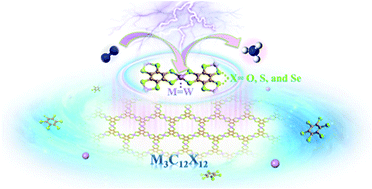Design strategies of two-dimensional metal–organic frameworks toward efficient electrocatalysts for N2 reduction: cooperativity of transition metals and organic linkers†
Abstract
Two-dimensional (2D) metal–organic frameworks (MOFs) serve as emerging electrocatalysts due to their high conductivity, chemical tunability, and accessibility of active sites. We herein proposed a series of 2D MOFs with different metal atoms and organic linkers with the formula M3C12X12 (M = Cr, Mo, and W; X = NH, O, S, and Se) to design efficient nitrogen reduction reaction (NRR) electrocatalysts. Our theoretical calculations showed that metal atoms in M3C12X12 can efficiently capture and activate N2 molecules. Among these candidates, W3C12X12 (X = O, S, and Se) show the best NRR performance due to their high activity and selectivity as well as low limiting potential (−0.59 V, −0.14 V, and −0.01 V, respectively). Moreover, we proposed a d-band center descriptor strategy to screen out the high activity and selectivity of M3C12X12 for the NRR. Therefore, our work not only demonstrates a class of promising electrocatalysts for the NRR but also provides a strategy for further predicting the catalytic activity of 2D MOFs.

- This article is part of the themed collections: Editor’s Choice: Functional MOFs and COFs and Nanoscale Most Popular 2021 Articles


 Please wait while we load your content...
Please wait while we load your content...